8K was prevalent at InfoComm 2023, but is it worth the hype?
8K is being talked about as the next evolution in display standards. We saw several manufacturers touting their big 8K LED screens front and centre at InfoComm 2023.
Remembering similar excitement over 4K some 10 years ago, Graham Kirkpatrick, Head of Solutions Team - UK & I at Sharp/NEC, considers what 8K might mean for the industry and whether it really is worth the hype.

What is 8K?
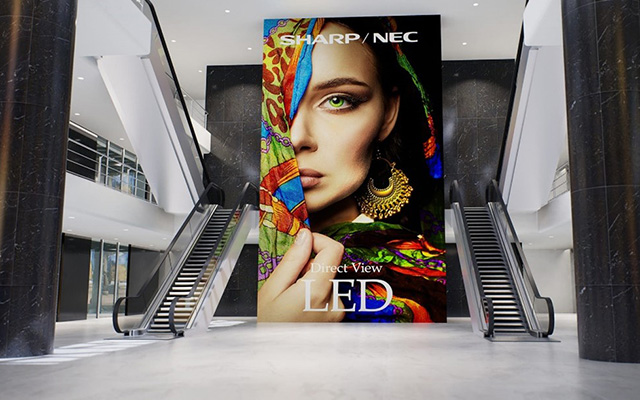
The designation 8K refers to the horizontal pixel count, which is close to 8,000 pixels. There are two terminology standards: 8K UHD, measuring 7,680 x 4,320 pixels (33.2MegaPixels), also known as UHD-2; and 8K DCI (Digital Cinema Initiatives), measuring 8,192 x 4,320. As with all resolution standards, the term 8K will be associated with all equipment within an 8K workflow, and not exclusively to the display standard.
So 8K is ALOT of pixels. To put it into perspective, 8K is four times as many pixels as 4K, and sixteen times as many pixels as FullHD resolution. The greater the pixel density, the sharper and more vibrant the image appears, displaying ‘pixel-free’ detail and a more reality-like viewing experience.
2014 was the year that saw heightened interest around 4K UHD, hailing it a new era of visual experience. For large format displays used in signage and meeting rooms, the transition to 4K UHD brought a noticeable improvement to the quality of content – but is there really any need to go further?
Reality-like visual experience
Today, 4K UHD is the de-facto standard in TVs and professional displays. Herein lies the first big challenge to the adoption of 8K, as Tobias Augustin, Manager Product Management at Sharp/NEC explained in a recent article in Installation Magazine: 8K resolution - a viable future in professional AV?

“After the big move from Full HD to 4K UHD, customers and users definitely saw that there is a benefit from higher resolutions. But 4K UHD was praised and marketed as the final step to ultimate realism, so picking up the same story and telling people that they now have to quadruple their resolution once again to have the REAL experience is something informed users will not buy into. The efforts and investments required to not only have end-devices like displays and projectors, but also capable infrastructure and of course content and playout systems achieving 8K are also very high.”
Even today, with 4K UHD the standard resolution in large format displays, many installations still use FullHD or upscaled FullHD as content. Native 4K UHD content is still not the norm. Especially in retail signage applications, the quality of content is often not matching the capabilities of the equipment, therefore it does not make sense to go even further than 4K UHD at a time when 4K UHD is still in its early days of adoption.
The Ecosystem is still moving to 4K UHD
It’s a similar scenario in corporate applications. Equipment used in meeting rooms and its supporting infrastructure is still striving to support 4K UHD resolutions. Tobias went on to say:
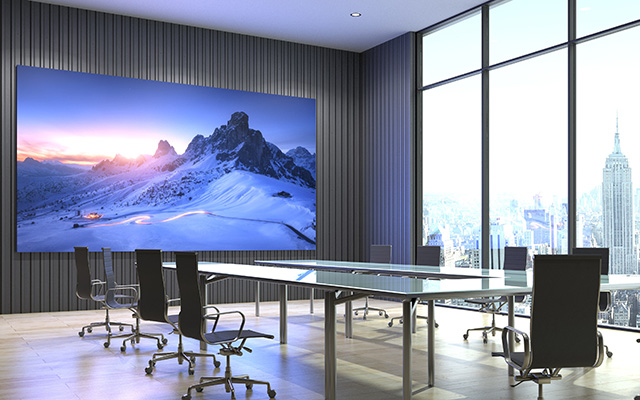
“Upgrading a meeting room to 8K while still using standard office notebooks with graphics cards that can only support up to UHD does not make sense. Many corporate customers are using all-in-one audio-video conferencing soundbars with cameras and microphones that use an integrated computing device to process the video. The majority of those devices only support resolutions up to UHD, while some only offer upscaled FullHD. Even if 8K meeting room displays could offer pixels small enough for ergonomic interaction, the playout devices only offer UHD, which means users would have zero benefit.”
The bandwidth required to stream content is also likely to be a major challenge. Even today, the streaming demand for 4K UHD is often too much to support, at 25Mbps – 50Mbps. Streaming 8K content, four times the resolution of 4K and double the frames per second, will demand considerably more.
Visual perception
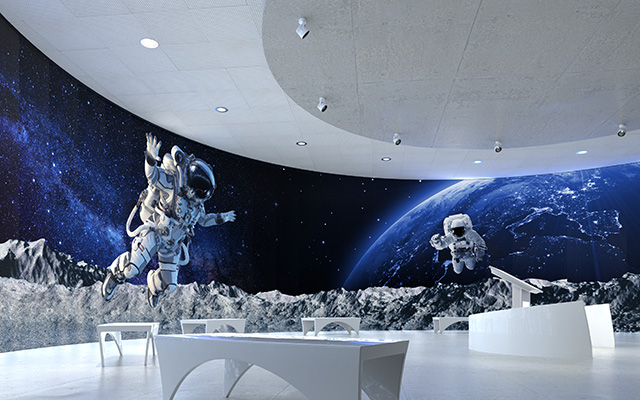
Higher resolutions or smaller pixels only make sense if they can be perceivable by the viewer. Whilst the shift to 4K UHD has brought noticeable benefits, would we really see any noticeable difference with 8K? For large format displays or TVs, you’re unlikely to need higher resolutions, and installations where viewers are further away from the display may not benefit either.
Installations covering a large surface may naturally demand higher resolutions to avoid pixels becoming too big and noticeable. It may therefore be beneficial to have higher resolutions for large video walls in control rooms or data-intense applications such as flight information. We are already able to deliver large surface 8K solutions with our existing portfolio of products to satisfy this requirement.
As yet, there is still much debate as to the potential of the Metaverse and how it may, or may not, transform the way we communicate. Yet we see gaming becoming more and more influential across all ages. Could the evolution of eSports and other evolving vertical spaces, such as virtual production, be the catalyst for 8K to become mainstream?
Responsible product development
The transition to new formats is very much a chicken and egg scenario. Until the content and supporting ecosystem is in place, there is little point in investing in an 8K display, even if it were to provide significant benefits in terms of the visual experience. Perhaps this is why we saw several manufacturers presenting their 8K offerings at InfoComm – a demonstration of their capability?
At Sharp/NEC, our approach is very different. We don’t develop technology for technology’s sake. Just because we can, this doesn’t mean that we should. As a customer-centric manufacturer, we are focused on the needs of the user, bringing to market products that offer genuine user benefits.
As the world strives to reduce the impact of climate change, is this the right time to be launching power-hungry products?
In the EU, 8K displays were effectively banned as of 1 March 2023 due to new EU energy efficiency requirements. However, the restrictions relate to the default picture mode, without restricting access to other higher energy consuming modes once the product has shipped, as long as an on-screen notification warns the user - a loophole which other manufacturers are clearly making full use of. You can read more about this in a recent article in AV Magazine.
In contrast, Sharp/NEC is currently focusing product innovation in a more sustainable direction.
DOWNLOAD A Lasting Vision: Sharp/NEC’s commitment to a sustainable future
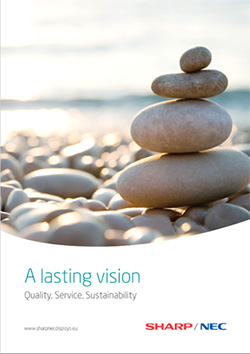
Innovation to improve sustainability
For large scale digital surfaces, Sharp/NEC can already offer a wide range of 8K solutions with our LED portfolio as well as LCD videowalls or edge-blended installation projectors. We are innovating to improve the energy efficiency and overall sustainability of these technologies. Here are examples of recent product launches:
LED FC Series
Featuring Flip-Chip Chip on Board (COB) technology, the FC Series delivers extreme contrast, high durability, and low energy use - up to 40% less power. Available in customisable modules and all-in-one bundle solutions in 0.95, 1.2 and 1.5mm pixel pitches.
PV Series Laser Projection
Acclaimed for its sustainable design and silent operation, the PV Series was awarded Best of Show by Projector Central at InfoComm 2023. The PV Series is the ideal upgrade opportunity to transition from lamp-based projection to benefit from efficient long life laser technology whilst making use of legacy lenses and mounting infrastructure to reduce waste.
eInk Technology
E Ink Holdings Inc and Sharp Corporation recently announced their collaboration to bring to market digital ePaper displays. When it comes to digital signage, achieving a power consumption of zero Watts during use is a ground-breaking step towards the carbon-neutral era.
Challenges ahead
Similar to the migration to UHD, bit-rates and file sizes for high-resolution content can become a bottle neck. Even if cameras can capture and end devices like displays can process the data, lossless storage and distribution may require upgraded equipment and infrastructure. Compression codecs are advancing and getting far more efficient year on year, but quadrupling the amount of data is something that may not be easy to compensate for quickly.
Even with market prices coming down, necessary investments may not be justifiable in terms of ROI.
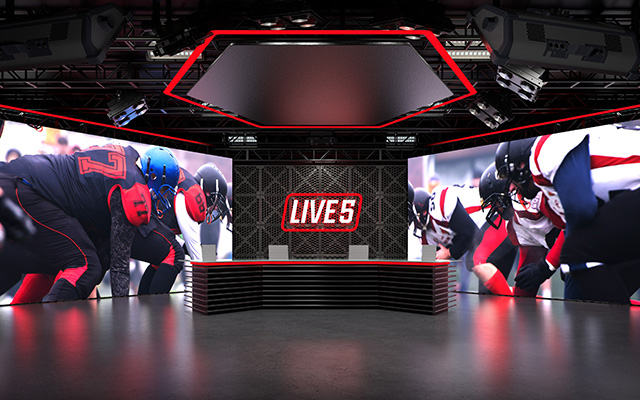
Higher resolutions like 8K are not game changing enough to generate new applications. Therefore, we do not expect a lot of new use cases to appear. A useful standard or metric that could help users select the right technology for their application would be DPI (dots per inch). This value can be used to identify how small pixels need to be to support the targeted application in the best possible way. Interactive displays need a higher DPI than signage displays or flight info boards in airports, for example. A DPI guideline for different applications would be desirable in order to achieve best possible ergonomics.
To conclude, while 8K resolution offers another leap forward for the professional and consumer industries, and will advance the way users create, consume, and interact with content like never seen before, the challenges are vast, and adoption may be halted before it has even started.
